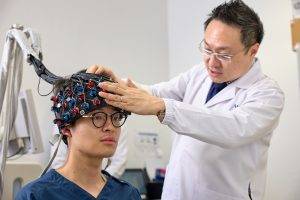ADHD affects both boys and girls, but girls are often misdiagnosed or overlooked.
We had an insightful conversation with Dr Jared Ng, Senior Consultant Psychiatrist and Medical Director at Connections MindHealth, delving into how the unique presentation of symptoms in girls often contributes to delayed diagnoses.
ADHD in Girls vs Boys
Attention Deficit Hyperactivity Disorder (ADHD) is a common neurodevelopmental condition affecting around 5% of Singaporean children. Dr Ng, explains that ADHD manifests through symptoms of inattention, hyperactivity, and impulsivity. Although the disorder affects both boys and girls, it presents differently in each gender, which influences how frequently and early it is diagnosed.
Read more: ADHD Surge: Reasons Behind the Rising Diagnoses
In boys, hyperactive symptoms tend to dominate. “A child with hyperactivity might always be running around the class, on the go, jumping on and off the furniture,” Dr Ng says.
Girls, however, are more likely to exhibit inattentive behaviours, which are harder to notice. This difference means that girls with ADHD may go undiagnosed for longer.
“In boys, we often see hyperactivity, while in girls, the inattentive subtype is more common.”
Recent studies highlight that girls may show more severe inattention symptoms compared to boys. The WHO’s South-East Asia Journal of Public Health notes that health systems in the region face challenges in diagnosing neurodevelopmental disorders (NDDs), such as ADHD. ADHD prevalence in Southeast Asia ranges from 5% to 18%, higher than the global average. However, the diagnostic focus often remains on boys, due to more noticeable hyperactive behaviours.
The Gender Gap in ADHD Diagnosis Beyond Southeast Asia
The diagnostic gap between boys and girls in ADHD extends beyond Southeast Asia. Studies worldwide show similar patterns. A 2020 study from Italy found that girls with ADHD score higher on attention problem scales, while boys typically exhibit externalising behaviours like aggression, hyperactivity, and impulsivity. Boys’ disruptive behaviours tend to catch the attention of teachers and parents more quickly, leading to earlier diagnosis and treatment.
Girls often display more internalising symptoms, such as inattention and anxiety, which can easily be mistaken for other conditions or dismissed as personality traits. This leads to many girls with ADHD remaining undiagnosed or receiving a diagnosis later in life.
These differences also shape treatment approaches. Boys are more likely to receive medications or behavioural therapy for ADHD, while girls often receive a misdiagnosis of anxiety or depression, which delays proper care. Experts urge the need for gender-sensitive diagnostic criteria to ensure girls receive timely and accurate diagnoses.
New Tools for Diagnosing ADHD in Singapore
In Singapore, advancements in diagnostic technology are aiming to close the gender gap in ADHD diagnosis. A series of new tests, including infrared brain scans and eye-tracking technology, offer more objective ways to assess ADHD in both children and adults. Developed by the National University of Singapore’s Institute for Health Innovation and Technology (iHealthtech), these tests complement traditional diagnostic methods like clinical interviews and questionnaires.

Image: IHealthtech NUS
Professor Roger Ho, a principal investigator at iHealthtech, highlighted the importance of these new methods.
He explained, “Psychiatry is the only medical discipline that diagnoses patients without objective diagnostic tools… This brain scan and eye tracker are like the prick test for diabetes. It’s objective, no one can change that.”
With an accuracy rate of about 77.95%, these tools help reduce the risk of misdiagnosis—particularly in individuals whose symptoms may not fit the traditional ADHD mould.
Since their launch, over 250 adults have undergone these tests, with 240 receiving an ADHD diagnosis. According to Prof Ho, the demand for adult ADHD diagnosis has risen significantly, likely due to increased awareness following the COVID-19 pandemic. He noted that many adults only recognise their symptoms after years of struggling with attention issues, often seeking help after they’ve encountered challenges in relationships or work.
ADHD Gains More Recognition
While ADHD is usually associated with children, many adults are now being diagnosed. Prof Ho reported an increase in adult ADHD cases at iHealthtech. More people are seeking assessments after experiencing long-term difficulties in areas like work and relationships.
Moonlake Lee, founder of Unlocking ADHD, received her ADHD diagnosis in 2019. Also speaking to The Straits Times, she shared how having an official diagnosis helped her better understand her condition. “Having something like a printout, that is looked at objectively and scientifically, I think will give a bit more reassurance,” she explained.
View this post on Instagram
“With ADHD, although there are limiting factors, these limiting factors can also be a strength.” says Dr Geraldine Tan, Principal Registered Psychologist of The Therapy Room. With diagnosis, it opens up effective management strategies for adults with ADHD to help them achieve their best potential.
Addressing the gaps in ADHD diagnosis, especially for girls, requires more than just new tools. It demands a shift in how we view neurodevelopmental disorders across genders. The fact that girls continue to be overlooked, both globally and in Southeast Asia, speaks to deeper biases in our health systems. But as individuals like Moonlake Lee continue to raise awareness, and as science pushes forward with more objective methods, there is an opportunity to redefine how we approach ADHD. The time has come to ensure that every child—regardless of gender—receives the care and understanding they deserve. Only then can we truly start bridging this gap.
Have a pressing question for a doctor? Medical Channel Asia has launched a community forum page where you can get questions answered by a medical specialist. Visit the community forum here.

